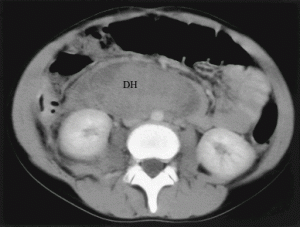Internal Medicine Practice Question: Blunt Trauma to the Upper Abdomen
Internal Medicine Practice Question

Source: American Journal of Gastroenterology (http://www.nature.com/ajg/journal/v93/n12/fig_tab/ajg1998593f1.html)
A 15-year-old male is brought to the ED after direct blunt trauma to the upper abdomen. The patient has epigastric pain accompanied by vomiting which occurred after the trauma. Vital signs are stable. The resident orders a barium study which shows duodenal obstruction. Additionally, a CT scan of the abdomen is ordered (see image above).
What is the best next step in management in this case?
- Ultrasound of the abdomen
- NPO plus antibiotics
- Endoscopic procedure (diagnostic and treatment)
- Exploratory laparotomy
- Conservative management (NG decompression and total parenteral nutrition)
- MRI of the abdomen
Duodenal hematomas usually occur following direct abdominal trauma and frequently occur in children. Some anatomical relationships (e.g. Duodenal retroperitoneal attachment; location anterior to the vertebral column; a well vascularized submucosa-subserosa through their plexus; weakness in the abdominal wall musculature) can serve as potential contributors to the development of such hematoma.
After direct abdominal trauma, blood collects between the submucosal and muscular layers of the duodenum causing obstruction. So patients commonly present with epigastric pain and vomiting due to the failure to pass gastric secretions past the obstructing hematoma. Statistically, most hematomas will resolve spontaneously in 7-15 days, and the best next step in this case is NG decompression and total parenteral nutrition. Surgery (focused laparotomy or a laparoscopic procedure),may be done to evacuate the hematoma if the conservative management fails.







